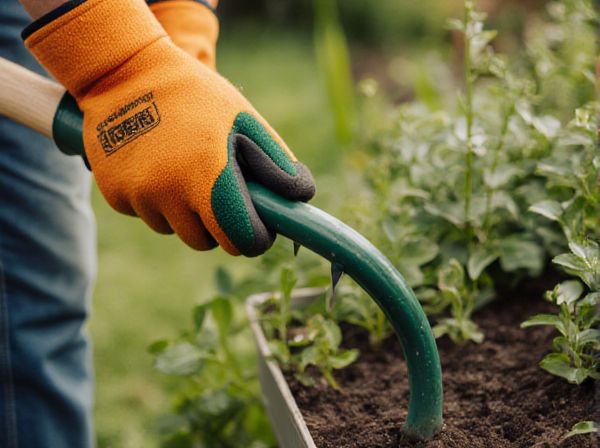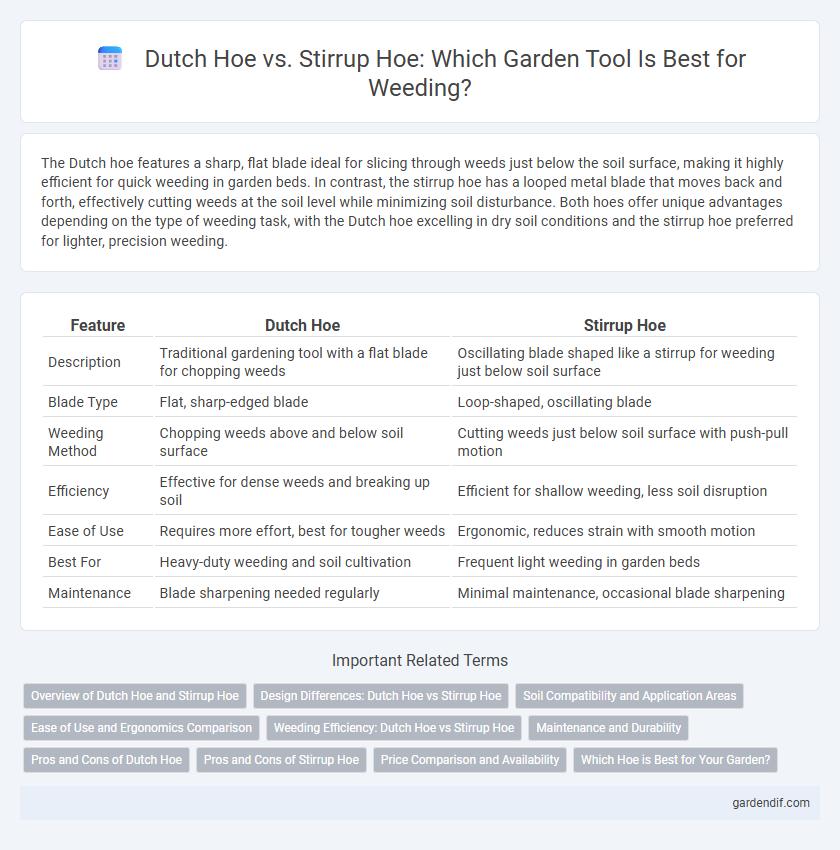
Dutch hoe vs Stirrup hoe Illustration
The Dutch hoe features a sharp, flat blade ideal for slicing through weeds just below the soil surface, making it highly efficient for quick weeding in garden beds. In contrast, the stirrup hoe has a looped metal blade that moves back and forth, effectively cutting weeds at the soil level while minimizing soil disturbance. Both hoes offer unique advantages depending on the type of weeding task, with the Dutch hoe excelling in dry soil conditions and the stirrup hoe preferred for lighter, precision weeding.
Table of Comparison
| Feature | Dutch Hoe | Stirrup Hoe |
|---|---|---|
| Description | Traditional gardening tool with a flat blade for chopping weeds | Oscillating blade shaped like a stirrup for weeding just below soil surface |
| Blade Type | Flat, sharp-edged blade | Loop-shaped, oscillating blade |
| Weeding Method | Chopping weeds above and below soil surface | Cutting weeds just below soil surface with push-pull motion |
| Efficiency | Effective for dense weeds and breaking up soil | Efficient for shallow weeding, less soil disruption |
| Ease of Use | Requires more effort, best for tougher weeds | Ergonomic, reduces strain with smooth motion |
| Best For | Heavy-duty weeding and soil cultivation | Frequent light weeding in garden beds |
| Maintenance | Blade sharpening needed regularly | Minimal maintenance, occasional blade sharpening |
Overview of Dutch Hoe and Stirrup Hoe
The Dutch hoe features a sharp, flat blade designed for slicing weeds just below the soil surface, making it ideal for precise weeding in gardens and rows. The stirrup hoe, also known as the scuffle hoe, has a looped blade that oscillates back and forth, efficiently cutting weeds with a push-pull motion while disturbing minimal soil. Both tools enhance weed control but differ in blade design and motion, catering to various gardening needs.
Design Differences: Dutch Hoe vs Stirrup Hoe
The Dutch hoe features a flat, sharp blade set at a fixed angle, designed for slicing weeds just below the soil surface with a chopping motion. In contrast, the stirrup hoe has a looped, oscillating blade that moves back and forth to cut weeds on both forward and backward strokes, reducing soil disturbance. These design differences optimize the Dutch hoe for precision cutting and the stirrup hoe for efficiency and ease of use in larger garden areas.
Soil Compatibility and Application Areas
The Dutch hoe excels in cultivating loose, dry soils and is ideal for surface weeding in vegetable gardens and flower beds. The Stirrup hoe performs efficiently in compacted, clay-rich soils, with its oscillating blade cutting weeds just below the soil surface in row crops and larger garden plots. Both tools offer versatile weed control, but soil texture and application area determine optimal use.
Ease of Use and Ergonomics Comparison
The Dutch hoe features a flat blade ideal for slicing weeds just below the soil surface, offering excellent control and minimal effort during repetitive motions. In contrast, the Stirrup hoe, or scuffle hoe, uses a looped blade that moves side-to-side to cut weeds, reducing wrist strain and improving efficiency in dense garden beds. Ergonomically, the Stirrup hoe's design promotes natural arm movement and less fatigue, while the Dutch hoe requires a more downward striking action, which can be more physically demanding over extended use.
Weeding Efficiency: Dutch Hoe vs Stirrup Hoe
The Dutch hoe excels at weeding efficiency by slicing through soil just below the surface, effectively cutting weed roots with a pushing motion, which minimizes soil disturbance and promotes faster weed removal. In contrast, the stirrup hoe uses a back-and-forth scraping action that targets weed stems at or just below the soil surface, making it highly efficient in loosening soil and preventing weed regrowth in tight spaces or between rows. Both tools enhance weed control, but the Dutch hoe is preferred for larger areas due to its aggressive root-cutting ability, while the stirrup hoe offers precision and versatility for detailed garden maintenance.
Maintenance and Durability
The Dutch hoe features a sturdy steel blade that requires regular sharpening to maintain its effectiveness and prevent rust, ensuring long-lasting durability. In contrast, the Stirrup hoe's looped blade design minimizes soil buildup, reducing cleaning time and wear while maintaining sharpness over extended use. Both tools benefit from occasional oiling and proper storage to enhance their lifespan and performance in garden maintenance.
Pros and Cons of Dutch Hoe
The Dutch hoe excels in rapid weed removal through its sharp, angled blade designed for efficient slicing just below the soil surface, promoting soil aeration and minimal root disturbance. However, it requires more physical effort and skillful angling to avoid damaging crops, making it less suitable for dense or close planting. Its simplicity and affordability contrast with the Stirrup hoe's oscillating blade, which offers easier maneuverability but may be less effective on tougher weeds.
Pros and Cons of Stirrup Hoe
The Stirrup Hoe excels in weeding efficiency due to its oscillating blade design that cuts weeds just below soil surface, reducing soil disturbance and preventing weed regrowth. Its lightweight frame and ergonomic handle minimize user fatigue, making it ideal for prolonged gardening sessions. However, it can struggle with tougher, woody weeds and may require supplementary tools for deep-rooted plants.
Price Comparison and Availability
Dutch hoes generally cost between $15 and $30, making them a budget-friendly option for gardeners, while stirrup hoes are priced higher, typically ranging from $25 to $50, reflecting their specialized design and efficiency. Availability for Dutch hoes is widespread, found in most garden centers and online retailers, whereas stirrup hoes may be less common, often stocked by specialty gardening stores and e-commerce platforms. Both tools offer essential soil cultivation benefits, but price and accessibility vary depending on the type and brand.
Which Hoe is Best for Your Garden?
The Dutch hoe features a flat blade ideal for shallow weeding and cultivating soil with minimal disturbance, making it perfect for annual flower beds and vegetable gardens. The Stirrup hoe, with its looped blade, excels at cutting weeds just below the soil surface by a push-pull motion, reducing strain and allowing for faster weeding in larger garden spaces. Choosing the best hoe depends on your garden's weed types and soil conditions, where the Dutch hoe suits light, surface weeding and the Stirrup hoe is more effective for deeper root cutting and extensive weed control.
Dutch hoe vs Stirrup hoe Infographic

 gardendif.com
gardendif.com